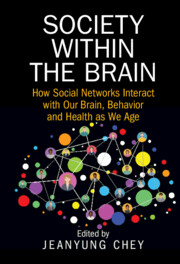Book contents
- Society within the Brain
- Society within the Brain
- Copyright page
- Dedication
- Contents
- Figures
- Tables
- Contributors
- Preface
- Introduction
- Part I Approaches to Society within the Brain
- Part II Society Interacting with Brain, Cognition, and Health in Late Life
- Part III An Individual’s Cognitive Aging with Others: Key Findings, Issues, and Implications
- Chapter 9 Social Relationships and Cognitive Function in Older Adults
- Chapter 10 Social Network and the Brain
- Chapter 11 Origins of Individual Differences in Social Behavior and the Social Brain
- Chapter 12 Preventing Dementia with Social Connection
- Index
- References
Chapter 12 - Preventing Dementia with Social Connection
from Part III - An Individual’s Cognitive Aging with Others: Key Findings, Issues, and Implications
Published online by Cambridge University Press: 28 September 2023
- Society within the Brain
- Society within the Brain
- Copyright page
- Dedication
- Contents
- Figures
- Tables
- Contributors
- Preface
- Introduction
- Part I Approaches to Society within the Brain
- Part II Society Interacting with Brain, Cognition, and Health in Late Life
- Part III An Individual’s Cognitive Aging with Others: Key Findings, Issues, and Implications
- Chapter 9 Social Relationships and Cognitive Function in Older Adults
- Chapter 10 Social Network and the Brain
- Chapter 11 Origins of Individual Differences in Social Behavior and the Social Brain
- Chapter 12 Preventing Dementia with Social Connection
- Index
- References
Summary
As the incidence of dementia is rapidly increasing around the world, especially in developing countries, it has become one of the most important health and social challenges facing humanity. This volume has reviewed research on social and psychological factors that could moderate the development of dementia in late life through social connection. This last chapter reviews psychosocial interventions connected with various aspects of social connection or lack thereof, such as social networks, social relationships, social engagement, loneliness, and sense of belonging, to examine interventions and their key factors that have shown efficacy in enhancing the moderators. It also introduces three evidence-based components that can be adopted in strategies and policies that aim to reduce the modifiable risks of dementia.
Keywords
- Type
- Chapter
- Information
- Society within the BrainHow Social Networks Interact with Our Brain, Behavior and Health as We Age, pp. 269 - 296Publisher: Cambridge University PressPrint publication year: 2023



